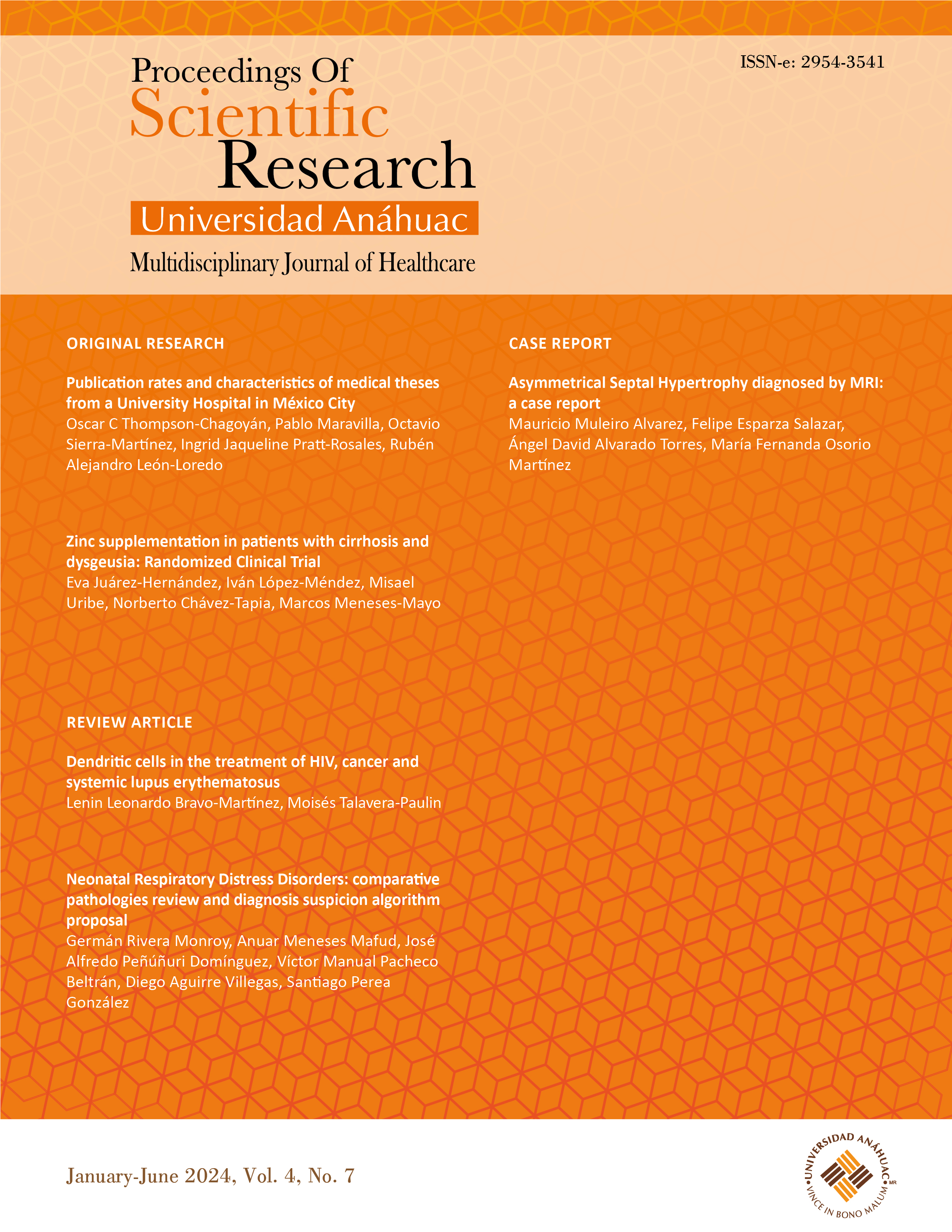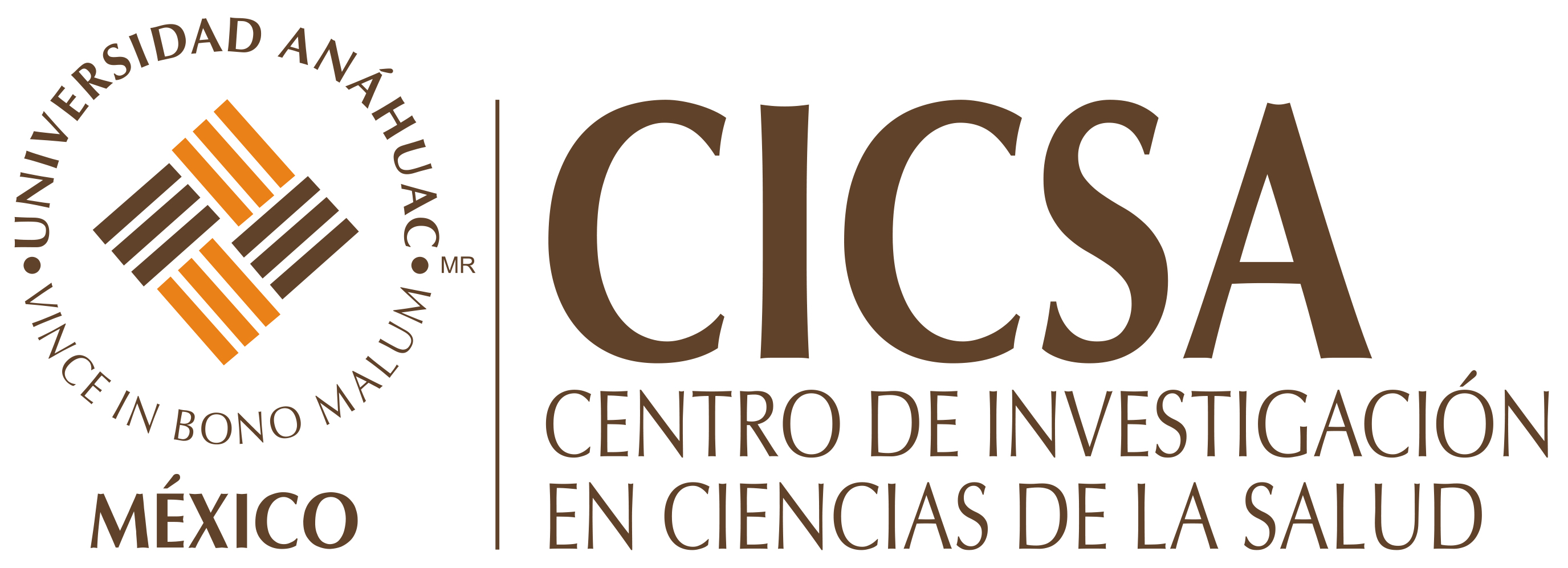Zinc supplementation in patients with cirrhosis and dysgeusia: Randomized Clinical Trial
DOI:
https://doi.org/10.36105/psrua.2024v4n7.02Keywords:
taste disorders, cirrhosis, zinc, liverAbstract
Background: Dysgeusia has been identified as part of liver cirrhosis (LC). Since zinc (Zn) is involved in taste and LC pathophysiology, this study aimed to evaluate the effect of zinc supplementation in patients with LC. Methods: Double-blinded randomized clinical trial, controlled with placebo in patients with LC. The intervention consisted of 100mg/day of Zn for six months. Improvement of dysgeusia was evaluated according to changes in perception (PT) and recognition (RT) thresholds of five flavors evaluated by ascending molar dilutions method. Differences were assessed by determining the size and the magnitude of effects, interpreted according to Common Language Effect Size, and determining the number needed to treat (NNT). Results: 50% (n=17) of patients were male, with a median age of 57 [51-63] years. After six months, 28 patients accomplished the follow-up; in patients who receive Zn, we observed a PT at a lower molar concentration in salty (1.0 [IQR 1.0-14.7] M vs. 12 [IQR 1.0-12] M, improvement probability 58% (NNT=6)), sweet (1.5 [IQR 1.5-3.5] M vs. 3.5 [IQR 1.5-4.0] M, improvement probability 57% (NNT=6)), sour (0.48 [IQR 0.48-0.48] M vs 0.48 [IQR 0.48-2.44] M, improvement probability 65% (NNT=3)) and umami (0.40 [IQR 0.40-0.40] M vs 0.70 [IQR 0.70-0.80] M, improvement probability 74% (NNT=2)) tastes compared to placebo group. With respect to RT, patients who received Zn, recognition of umami taste was observed at a lower molar concentration (0.70 [IQR 0.40-1.17] M vs 0.90 [0.70-1.1] M, improvement probability 59% (NNT=5)) compared to placebo. Conclusion: Patients supplemented with GZn show an improvement probability of PT higher than 55% for salty, sweet, sour, and umami tastes. Meanwhile, the improvement probability of RT for umami taste is 59%.
Downloads
PLUMX metrics
References
Zuñiga-Aguilar E, Ramírez-Fernández O. Fibrosis and hepatic regeneration mechanism. Transl Gastroenterol Hepatol; 7. https://doi.org/10.21037/tgh.2020.02.21 DOI: https://doi.org/10.21037/tgh.2020.02.21
Cheemerla S, Balakrishnan M. Global Epidemiology of Chronic Liver Disease. Clin Liver Dis (Hoboken) 2021; 17: 365–370. https://doi.org/10.1002/cld.1061 DOI: https://doi.org/10.1002/cld.1061
Fark T, Hummel C, Hähner A, et al. Characteristics of taste disorders. Eur Arch Otorhinolaryngol 2013; 270: 1855–1860. https://doi.org/10.1007/s00405-012-2310-2 DOI: https://doi.org/10.1007/s00405-012-2310-2
Devere R. Disorders of Taste and Smell. Continuum (Minneap Minn) 2017; 23: 421–446. https://doi.org/10.1212/con.0000000000000463 DOI: https://doi.org/10.1212/CON.0000000000000463
Bromley SM. Neurolocalization of taste disorders. In: Handbook of Clinical Neurology. Handb Clin Neurol, pp. 303–323. https://doi.org/10.1016/b978-0-444-63855-7.00019-8 DOI: https://doi.org/10.1016/B978-0-444-63855-7.00019-8
Burch RE, Sackin DA, Ursick JA, et al. Decreased Taste and Smell Acuity in Cirrhosis. Arch Intern Med 1978; 138: 743–746. PMID:646537. DOI: https://doi.org/10.1001/archinte.138.5.743
Smith FR, Henkin RI, Dell RB. Disordered Gustatory Acuity in Liver Disease. Gastroenterology 1976; 70: 568–571. PMID:1254140. DOI: https://doi.org/10.1016/S0016-5085(76)80497-0
Deems RO, Friedman MI, Friedman LS, et al. Chemosensory function, food preferences and appetite in human liver disease. Appetite 1993; 20: 209–216. https://www.sciencedirect.com/science/article/abs/pii/S0195666383710214?via%3Dihub DOI: https://doi.org/10.1006/appe.1993.1021
Henkin RI. Zinc in taste function : A critical review. Biol Trace Elem Res 1984; 6: 263–280. https://doi.org/10.1007/bf02917511 DOI: https://doi.org/10.1007/BF02917511
Henkin RI, Bradley DF. Hypogeusia corrected by Ni++ and Zn++. Life Sci 1970; 9: 701–709. https://doi.org/10.1016/0024-3205(70)90278-x DOI: https://doi.org/10.1016/0024-3205(70)90278-X
Weismann K, Christensen E, Dreyer V. Zinc Supplementation in Alcoholic Cirrhosis. A Double-Blind Clinical Trial. Acta Med Scand 1979; 205: 361–366. https://doi.org/10.1111/j.0954-6820.1979.tb06065.x DOI: https://doi.org/10.1111/j.0954-6820.1979.tb06065.x
Sturniolo GC, D’Inca R, Parisi G, et al. Taste alterations in liver cirrhosis: Are they related to zinc deficiency? J Trace Elem Electrolytes Health Dis 1992; 6: 15–19. PMID:1638179
Nagao Y, Matsuoka H, Kawaguchi T, et al. Aminofeel® improves the sensitivity to taste in patients with HCV-infected liver disease. Med Sci Monit. 2010 Apr;16(4):PI7-12. PMID:20357731
Cancer Institute N. Common Terminology Criteria for Adverse Events. In: Definitions. Epub ahead of print 2020. https://doi.org/10.32388/ERJXIQ DOI: https://doi.org/10.32388/ERJXIQ
Amerine MA, Pangborn RM, Roessler EB, et al. CHAPTER 2 – The Sense of Taste. In: Principles of Sensory Evaluation of Food. 1965, pp. 28-144. DOI: https://doi.org/10.1016/B978-1-4832-0018-7.50006-4
Detsky AS, Mclaughlin J, Baker JP, et al. What is subjective global assessment of nutritional status? Journal of Parenteral and Enteral Nutrition 1987; 11: 8–13. https://doi.org/10.1177/014860718701100108 DOI: https://doi.org/10.1177/014860718701100108
Amodio P, Bemeur C, Butterworth R, et al. The nutritional management of hepatic encephalopathy in patients with cirrhosis: International society for hepatic encephalopathy and nitrogen metabolism consensus. Hepatology 2013; 58: 325–336. https://doi.org/10.1002/hep.26370 DOI: https://doi.org/10.1002/hep.26370
Casanovas T, Jané L, Herdman M, et al. Assessing outcomes in liver disease patients: Reliability and validity of the Spanish version of the liver disease quality of life questionnaire (LDQOL 1.0). Value in Health 2010; 13: 455–462. https://doi.org/10.1111/j.1524-4733.2009.00688.x DOI: https://doi.org/10.1111/j.1524-4733.2009.00688.x
Hernández-Avila M, Romieu I, Parra S, et al. Validity and reproducibility of a food frequency questionnaire to assess dietary intake of women living in Mexico City. Salud Publica Mex 1998; 40: 133–140. https://pubmed.ncbi.nlm.nih.gov/9617194/ DOI: https://doi.org/10.1590/S0036-36341998000200005
INCMNSZ. Tablas de composición de alimentos y productos alimenticios (versión condensada 2015): huevo, gallina blanco, entero crudo., Available at: https://isbn.cloud/9786077797197/tablas-de-composicion-de-alimentos-y-productos-alimenticios-mexicanos-version-condensada-2015/ (2016, accessed 24 February 2023).
Bellisle F. Glutamate and the UMAMI taste: Sensory, metabolic, nutritional and behavioural considerations. A review of the literature published in the last 10 years. Neurosci Biobehav Rev 1999; 23: 423–438. https://doi.org/10.1016/s0149-7634(98)00043-8 DOI: https://doi.org/10.1016/S0149-7634(98)00043-8
Jáuregui-Lobera I, Bolaños Ríos P. ¿Qué motiva la elección de los alimentos en los consumidores? Nutr Hosp 2011; 26: 1313–1321.
Madden AM, Bradbury W, Morgan MY. Taste perception in cirrhosis: Its relationship to circulating micronutrients and food preferences. Hepatology 1997; 26: 40–48. https://doi.org/10.1002/hep.510260106 DOI: https://doi.org/10.1002/hep.510260106
Morando F, Rosi S, Gola E, et al. Adherence to a moderate sodium restriction diet in outpatients with cirrhosis and ascites: a real-life cross-sectional study. Liver International 2015; 35: 1508–1515. https://doi.org/10.1111/liv.12583 DOI: https://doi.org/10.1111/liv.12583
Chavez-Tapia NC, Cesar-Arce A, Barrientos-Gutiérrez T, et al. A systematic review and meta-analysis of the use of oral zinc in the treatment of hepatic encephalopathy. Nutr J; 12. Epub ahead of print 2013. https://doi.org/10.1186/1475-2891-12-74 DOI: https://doi.org/10.1186/1475-2891-12-74
Traub J, Reiss L, Aliwa B, et al. Malnutrition in Patients with Liver Cirrhosis. Nutrients 2021, Vol 13, Page 540 2021; 13: 540. https://doi.org/10.3390/nu13020540 DOI: https://doi.org/10.3390/nu13020540
Maharshi S, Sharma BC, Srivastava S. Malnutrition in cirrhosis increases morbidity and mortality. J Gastroenterol Hepatol 2015; 30: 1507–1513. https://doi.org/10.1111/jgh.12999 DOI: https://doi.org/10.1111/jgh.12999
Shiraki M, Nishiguchi S, Saito M, et al. Nutritional status and quality of life in current patients with liver cirrhosis as assessed in 2007–2011. Hepatology Research 2013; 43: 106–112. https://doi.org/10.1111/hepr.12004 DOI: https://doi.org/10.1111/hepr.12004
Rojas-Loureiro G, Servín-Caamaño A, Pérez-Reyes E, et al. Malnutrition negatively impacts the quality of life of patients with cirrhosis: An observational study. World J Hepatol 2017; 9: 263–269. https://doi.org/10.4254/wjh.v9.i5.263 DOI: https://doi.org/10.4254/wjh.v9.i5.263
Loria A, Escheik C, Gerber NL, et al. Quality of life in cirrhosis. Curr Gastroenterol Rep; 15. Epub ahead of print 1 January 2013. https://doi.org/10.1007/s11894-012-0301-5 DOI: https://doi.org/10.1007/s11894-012-0301-5
Ahluwalia V, Heuman DM, Feldman G, et al. Correction of hyponatraemia improves cognition, quality of life, and brain oedema in cirrhosis. J Hepatol 2015; 62: 75–82. https://doi.org/10.1016/j.jhep.2014.07.033 DOI: https://doi.org/10.1016/j.jhep.2014.07.033
Nishikawa H, Asai A, Fukunishi S. The Significance of Zinc in Patients with Chronic Liver Disease. Nutrients; 14. Epub ahead of print 1 November 2022. https://doi.org/10.3390/nu14224855 DOI: https://doi.org/10.3390/nu14224855

Published
How to Cite
Issue
Section
License
Copyright (c) 2024 Eva Juárez-Hernández, Iván López-Méndez, Misael Uribe, Norberto Chávez-Tapia, Marcos Meneses-Mayo

This work is licensed under a Creative Commons Attribution-NonCommercial-NoDerivatives 4.0 International License.
All the intellectual content found in this publication is licensed to the consumer public under the figure of Creative Commons©, unless the author of said content has agreed otherwise or limited said faculty to "Proceedings of Scientific Research Universidad Anáhuac. Multidisciplinary Journal of Healthcare©" or "Universidad Anáhuac Mexico©" in writing and expressly.
Proceedings of Scientific Research Universidad Anáhuac. Multidisciplinary Journal of Healthcare is distributed under a Creative Commons Attribution-NonCommercial-NoDerivatives 4.0 International License.
The author retains the economic rights without restrictions and guarantees the journal the right to be the first publication of the work. The author is free to publish his article in any other medium, such as an institutional repository.












